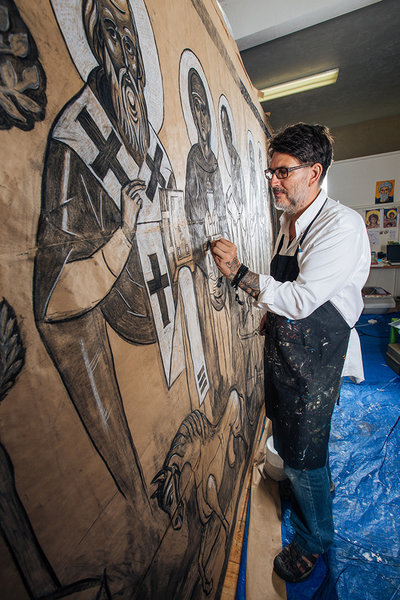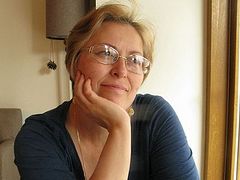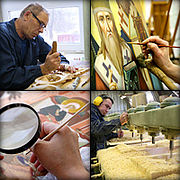July 30, 2015
 Using charcoal, artist Daniel Balter sketches saints in his studio at Whiteaker's St. John the Wonderworker Orthodox Church.
Using charcoal, artist Daniel Balter sketches saints in his studio at Whiteaker's St. John the Wonderworker Orthodox Church. Standing beneath the oculus of the church dome with lazy afternoon sunlight filtering through its circular opening, artist Daniel Balter points to a 6-foot-tall figure he sketched in charcoal on the walls the night before. It’s archangel Michael, complete with flowing robes, wings and halo.
Balter motions to the room and the iconostasis—a red-and-gold wall adorned with saints that traditionally separates a church's nave from its sanctuary. It was in this room, he tells me, that he used to see punk bands play.
“This used to be Icky’s Teahouse,” Balter says. He recalls how hundreds of punk kids would hang out in the parking lot and how he once got in a fight where the church now has its bookstore. Balter remembers junkies buzzing around the porch of the house next door, now the home of the priest.
“I came to punk shows here long before I knew what Orthodox Christianity was,” he says.
That was more than 20 years ago, when Balter was a self-described hippie with “Indian braids and a big beard,” and what was once Icky’s—a crusty hotbed for counterculture and unrest in the Whiteaker—has long since reformed into St. John the Wonderworker, an Orthodox Christian church.
Today, the building lends the neighborhood an iconic charm, with its salmon-colored walls, church bells and blue-and-gold onion domes poking above the low skyline.
For Balter, the church has become a unique kind of trinity: home, studio, temple. He moved onto the grounds about a month ago, where he has his living quarters and a separate artist studio. He attends several services a week.
The change from punk to piety was set in motion in 2012, when the church’s priest and Balter’s longtime friend, Father Daniel Mackay—affectionately referred to by many as Father Daniel—approached him with a request: to paint icons, or saints, on a pair of church doors in the traditional Byzantine style. Before long, the commission expanded from the doors to include the interior walls of the church and its ceiling, filling the space with dozens, potentially even hundreds, of larger-than-life saints, as well as the religious scenes The Entrance of Theotokos and The Presentation of Christ.
“It’s part of our tradition,” Father Mackay says of the beautification of the church. “God as Christ came as both word and image.” He adds, “I think every Orthodox Church between Northern California and Portland would like to have it.”
Balter and Mackay predict the project will take three years, and with the financial backing of some private church members, Balter will go on a sort of grand tour of Serbia, Rome and Mount Athos in Greece to study Orthodox Christian iconography.
This commission is starkly different from standard artist-patron transactions of today, harkening back to a period when centers of worship were the main propellers of the visual arts. Upon commencing the project, however, something was nagging at both the artist and some members of the church: Balter was not an Orthodox Christian.
“One of them took me on a walk and talked to me about their qualms,” Balter says. He pauses for a moment and smiles. “Father Daniel, he knew I wasn’t Orthodox and yet, it’s really strange,” he says of being asked to do the commission. “I think there’s some providence involved because it was the job, it was the commission, that made me get closer to the church.”
Balter, who moved to North Polk Street in Eugene with his family when he was 5, was raised Catholic, but eventually started living a lifestyle he jokingly describes as "pagan." He was 10 the first time he got high sniffing glue. At 11, he overdosed on phenobarbital. By the time Balter was an adult he was addicted to heroin, eventually overdosing in his 30s.
Throughout this time, Balter was also developing his artistic skills, from working as a tattoo artist to taking art classes at Lane Community College. He painted murals in nightclubs, including one in the original John Henry’s on E. 11th Ave. Balter and Mackay also met during this time, circa the mid-90s.
Balter later met a woman who inspired him to get clean (he has been for 15 years now), and they moved to Portland and eventually married. He painted and sold landscapes, as well as doing private commissions. After 12 years together, the marriage fell apart and Balter became depressed, leading him to paint a series of 50 “suicide” portraits.
Mackay, not yet a priest, came to visit and saw a self-portrait Balter had painted in which he has a gun to his head. “He said, ‘You shouldn’t be alone during this time. Why don’t you come and live with us?’” Balter recalls.
Balter returned to Eugene and moved into the basement of the house where Mackay, his wife and an octogenarian he affectionately calls “Ginny” lived. Ginny Bingham, who recently passed away, encouraged him to immerse himself in his art to get past the heartache.
And so he did. Balter enrolled in art classes again at LCC, where he came under the tutelage of renowned local oil painter Adam Grosowsky. He went on to take art classes at the UO, eventually becoming an instructor in drawing and painting at the EMU Craft Center, where he still teaches.
Meanwhile, Mackay, after teaching English literature at the UO, became a deacon at the church and, after two years, a priest. He has been the priest for St. John the Wonderworker for four years.
Mackay and Balter no longer live together, but they’re close. Mackay lives in a house adjacent to the church with his wife and daughter, about 100 feet away from the artist’s living quarters. A year ago they became closer still. After a period of what Balter calls “flirting” with Orthodoxy, Mackay baptized Balter on the shores of Fall Creek Reservoir last summer.
Balter explains that, traditionally, iconographers were required to be Orthodox, a spirituality that comes through in their painted icons.
“It’s one thing to walk into a church and have a bunch of rot inside of you and be able to put a smile on your face and fake it,” he says. “But to paint, they’re going to see what’s inside of me, on the wall, and if it’s not there, they’re going to know. So I knew I couldn’t fake it, which meant I had to do some work to get closer.”
Behind St. John the Wonderworker lies a couple acres of grassy land, dotted with a small playground, a garden, picnic tables and Balter’s studio, which abuts one of Ninkasi brewery’s turquoise walls. Sitting at a picnic table after a Sunday service, Mackay explains that Balter was an obvious choice for commission. “He’s a very skilled artist,” he says. “If you have a good knife, you sharpen it.”
Mackay and the church also want Balter to sharpen his knowledge of Orthodox Christian iconography, which is more a hybrid of craft and prayer than an artistic endeavor.
“This is not art in the sense of expression,” Mackay says. “It’s a spiritual discipline. For the iconographer, the painting of the image is prayer.” He adds, “The idea is for the icons to be windows to heaven.”
The artist will travel to Serbia and Greece, with a stopover in Rome, to see the roots of this visual tradition “as soon as I get my passport,” Balter says. In the meantime, he pours over stacks of books about iconography and the Orthodox Christian Church, learning the strict visual rules and codes of painting saints. For example, Balter must avoid painting specific shadows on saints, as light is supposed to emanate from these heavenly figures, not reflect off of them.
“As a painter, reading art history you can’t help but wonder what it would have been like to paint the Sistine Chapel ceiling,” Balter says. “To get a chance to paint a church—that’s like a dream in a way.”
But it’s also more than a dream.
“The whole thing is about transformation,” he says. Painting icons is an “alchemical/incarnational process” of the artist transforming paint minerals into a sacred image, Balter explains, while also noting the change from Icky’s to St. John the Wonderworker, and from addict to iconographer.
“The whole thing is about transcendence,” he says.



